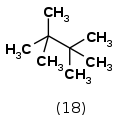- Octane (Chemie)
-
Die Octane sind eine Gruppe von aliphatischen, gesättigten Kohlenwasserstoffen bzw. Alkanen, die alle acht Kohlenstoffatome im Molekül enthalten. Die Summenformel der Verbindungen ist C8H18. Es existieren 18 Isomere:
- n-Octan
- 2-Methylheptan
- 3-Methylheptan
- 4-Methylheptan
- 2,2-Dimethylhexan
- 2,3-Dimethylhexan
- 2,4-Dimethylhexan
- 2,5-Dimethylhexan
- 3,3-Dimethylhexan
- 3,4-Dimethylhexan
- 3-Ethylhexan
- 2,2,3-Trimethylpentan
- 2,2,4-Trimethylpentan (iso-Octan)
- 2,3,3-Trimethylpentan
- 2,3,4-Trimethylpentan
- 3-Ethyl-2-methylpentan
- 3-Ethyl-3-methylpentan
- 2,2,3,3-Tetramethylbutan
Neben dem n-Octan können drei Methylheptane, sechs Dimethylhexane, ein Ethylhexan, vier Trimethylpentane, zwei Ethylmethylpentane und ein Tetramethylbutan formuliert werden.
3-Methylheptan, 2,3-Dimethylhexan, 2,4-Dimethylhexan und 2,2,3-Trimethylpentan besitzen ein Stereozentrum und sind daher chirale Verbindungen. Sie besitzen jeweils zwei optisch aktive (D/L)-Stereoisomere. 3,4-Dimethylhexan besitzt zwei Stereozentren. Hiervon gibt es zwei optisch aktive (D/L)-Stereoisomere und eine meso-Form.
Bis auf das 2,2,3,3-Tetramethylbutan sind die Octanisomere bei Raumtemperatur flüssig.
Vergleich physikalischer Eigenschaften der Octane (1)[1] Name n-Octan[2] 2-Methylheptan[3] 3-Methylheptan[4] 4-Methylheptan[5] 2,2-Dimethylhexan[6] 2,3-Dimethylhexan[7] 2,4-Dimethylhexan[8] 2,5-Dimethylhexan[9] 3,3-Dimethylhexan[10] Andere Namen Diisopropyl Strukturformel (1) (2) (3) (4) (5) (6) (7) (8) (9) CAS-Nummer 111-65-9 592-27-8 589-81-1 589-53-7 590-73-8 584-94-1 589-43-5 592-13-2 563-16-6 111002-96-1
[(R)-Enantiomer]393810-12-3
[(R)-Enantiomer]116836-51-2
[(R)-Enantiomer]6131-25-5
[(S)-Enantiomer]393810-11-2
[(S)-Enantiomer]53990-98-0
[(S)-Enantiomer]PubChem 356 11512 11551 11447 11511 11592 Summenformel C8H18 Molare Masse 114,22 g·mol−1 Kurzbeschreibung farblose Flüssigkeiten Schmelzpunkt −56,8 °C −110 °C −121 °C (Racemat) −121 °C −121 °C −91 °C −126 °C Siedepunkt 126 °C 117 °C 120 °C 117 °C 106 °C 116 °C 110 °C 109 °C 112 °C Dampfdruck (20 °C) 14 mbar 40 mbar Dampfdruck (30 °C) 24 mbar Dampfdruck (50 °C) 67 mbar 95 mbar 95 mbar 95 mbar 145 mbar 103 mbar 135 mbar 135 mbar Dichte 0,70 g·cm−3 0,70 g·cm−3 0,71 g·cm−3 0,70 g·cm−3 0,70 g·cm−3 0,71 g·cm−3 0,70 g·cm−3 0,69 g·cm−3 Löslichkeit 0,7 mg·l−1 (20 °C) 0,7 mg·l−1 (20 °C) 0,7 mg·l−1 (20 °C) 0,7 mg·l−1 (20 °C) 2,5 mg·l−1 (20 °C) 2,5 mg·l−1 (20 °C) 2,5 mg·l−1 (20 °C) 0,7 mg·l−1 (20 °C) 0,7 mg·l−1 (20 °C) Flammpunkt 12 °C 6 °C 6 °C 6 °C −3 °C 5 °C 3 °C 2 °C Untere Explosionsgrenze (UEG) 0,8 Vol% 0,8 Vol% 0,8 Vol% 0,8 Vol% 0,8 Vol% 0,8 Vol% 0,8 Vol% 38 g·m−3 40 g·m−3 40 g·m−3 40 g·m−3 40 g·m−3 40 g·m−3 40 g·m−3 Obere Explosionsgrenze (OEG) 6,5 Vol% 6,5 Vol% 6,5 Vol% 6,5 Vol% 6,5 Vol% 6,5 Vol% 6,5 Vol% 310 g·m−3 310 g·m−3 310 g·m−3 310 g·m−3 310 g·m−3 310 g·m−3 310 g·m−3 Zündtemperatur 205 °C 410 °C 435 °C Vergleich physikalischer Eigenschaften der Octane (2)[1] Name 3,4-Dimethylhexan[11] 3-Ethylhexan[12] 2,2,3-Trimethylpentan[13] 2,2,4-Trimethylpentan[14] 2,3,3-Trimethylpentan[15] 2,3,4-Trimethylpentan[16] 3-Ethyl-2-methylpentan[17] 3-Ethyl-3-methylpentan[18] 2,2,3,3-Tetramethylbutan[19] Andere Namen Isooctan Hexamethylethan Strukturformel (10) (11) (12) (13) (14) (15) (16) (17) (18) CAS-Nummer 583-48-2 619-99-8 564-02-3 540-84-1 560-21-4 565-75-3 609-26-7 1067-08-9 594-82-1 52919-17-2
[(R,R)-Enantiomer]54665-47-3
[(R)-Enantiomer]10203-80-2
[(S,S)-Enantiomer]40824-48-4
[(S)-Enantiomer]52949-33-4
[(3R,4S)-Enantiomer]PubChem 638048 12096 109070 11863 14018 11675 Summenformel C8H18 Molare Masse 114,22 g·mol−1 Kurzbeschreibung farblose Flüssigkeiten fest Schmelzpunkt −112 °C (Racemat) −107 °C −100,7 °C −110 °C −115 °C −91 °C 100,8 °C[20] Siedepunkt 118 °C 119 °C 110 °C 99 °C 115 °C 113 °C 116 °C 118 °C 107 °C (1020 mbar) Dampfdruck (20 °C) 52 mbar Dampfdruck (30 °C) 84 mbar Dampfdruck (50 °C) 100 mbar 95 mbar 140 mbar 195 mbar 120 mbar 120 mbar 110 mbar 110 mbar Dichte 0,72 g·cm−3 0,72 g·cm−3 0,72 g·cm−3 0,69 g·cm−3 0,72 g·cm−3 0,72 g·cm−3 0,72 g·cm−3 0,727 g·cm−3 0,82 g·cm−3 Löslichkeit 0,7 mg·l−1 (20 °C) 0,7 mg·l−1 (20 °C) 2,5 mg·l−1 (20 °C) 0,56 mg·l−1 (25 °C) 2,5 mg·l−1 (20 °C) 2,5 mg·l−1 (20 °C) 0,7 mg·l−1 (20 °C) 0,7 mg·l−1 (20 °C) 0,7 mg·l−1 (20 °C)) Flammpunkt 5-10 °C 5 °C 3 °C −12 °C 6 °C 4 °C 7 °C <1 °C Untere Explosionsgrenze (UEG) 0,8 Vol% 1,0 Vol% 0,8 Vol% 40 g·m−3 45 g·m−3 40 g·m−3 Obere Explosionsgrenze (OEG) 6,5 Vol% 6,0 Vol% 6,5 Vol% 310 g·m−3 290 g·m−3 310 g·m−3 Zündtemperatur 430 °C 410 °C 425 °C 460 °C Einzelnachweise
- ↑ a b alle Daten wurden aus der GESTIS-Datenbank entnommen, die Einzellinks stehen in der Name-Zeile.
- ↑ Eintrag zu Octan in der GESTIS-Stoffdatenbank des IFA, abgerufen am 20. Oktober 2010 (JavaScript erforderlich).
- ↑ Eintrag zu 2-Methylheptan in der GESTIS-Stoffdatenbank des IFA, abgerufen am 20. Oktober 2010 (JavaScript erforderlich).
- ↑ Eintrag zu 3-Methylheptan in der GESTIS-Stoffdatenbank des IFA, abgerufen am 20. Oktober 2010 (JavaScript erforderlich).
- ↑ Eintrag zu 4-Methylheptan in der GESTIS-Stoffdatenbank des IFA, abgerufen am 20. Oktober 2010 (JavaScript erforderlich).
- ↑ Eintrag zu 2,2-Dimethylhexan in der GESTIS-Stoffdatenbank des IFA, abgerufen am 20. Oktober 2010 (JavaScript erforderlich).
- ↑ Eintrag zu 2,3-Dimethylhexan in der GESTIS-Stoffdatenbank des IFA, abgerufen am 20. Oktober 2010 (JavaScript erforderlich).
- ↑ Eintrag zu 2,4-Dimethylhexan in der GESTIS-Stoffdatenbank des IFA, abgerufen am 20. Oktober 2010 (JavaScript erforderlich).
- ↑ Eintrag zu 2,5-Dimethylhexan in der GESTIS-Stoffdatenbank des IFA, abgerufen am 20. Oktober 2010 (JavaScript erforderlich).
- ↑ Eintrag zu 3,3-Dimethylhexan in der GESTIS-Stoffdatenbank des IFA, abgerufen am 20. Oktober 2010 (JavaScript erforderlich).
- ↑ Eintrag zu 3,4-Dimethylhexan in der GESTIS-Stoffdatenbank des IFA, abgerufen am 20. Oktober 2010 (JavaScript erforderlich).
- ↑ Eintrag zu 3-Ethylhexan in der GESTIS-Stoffdatenbank des IFA, abgerufen am 20. Oktober 2010 (JavaScript erforderlich).
- ↑ Eintrag zu 2,2,3-Trimethylpentan in der GESTIS-Stoffdatenbank des IFA, abgerufen am 20. Oktober 2010 (JavaScript erforderlich).
- ↑ Eintrag zu 2,2,4-Trimethylpentan in der GESTIS-Stoffdatenbank des IFA, abgerufen am 20. Oktober 2010 (JavaScript erforderlich).
- ↑ Eintrag zu 2,3,3-Trimethylpentan in der GESTIS-Stoffdatenbank des IFA, abgerufen am 20. Oktober 2010 (JavaScript erforderlich).
- ↑ Eintrag zu 2,3,4-Trimethylpentan in der GESTIS-Stoffdatenbank des IFA, abgerufen am 20. Oktober 2010 (JavaScript erforderlich).
- ↑ Eintrag zu 3-Ethyl-2-methylpentan in der GESTIS-Stoffdatenbank des IFA, abgerufen am 20. Oktober 2010 (JavaScript erforderlich).
- ↑ Eintrag zu 3-Ethyl-3-methylpentan in der GESTIS-Stoffdatenbank des IFA, abgerufen am 20. Oktober 2010 (JavaScript erforderlich).
- ↑ Eintrag zu 2,2,3,3-Tetramethylbutan in der GESTIS-Stoffdatenbank des IFA, abgerufen am 20. Oktober 2010 (JavaScript erforderlich).
- ↑ Scott, D.W.; Douslin, D.R.; Gross, M.E.; Oliver, G.D.; Huffman, H.M.: 2,2,3,3-Tetramethylbutane: Heat capacity, heats of transition, fusion and sublimation, vapor pressure, entropy and thermodynamic functions in J. Am. Chem. Soc. 74 (1952) 883-887.
Wikimedia Foundation.











